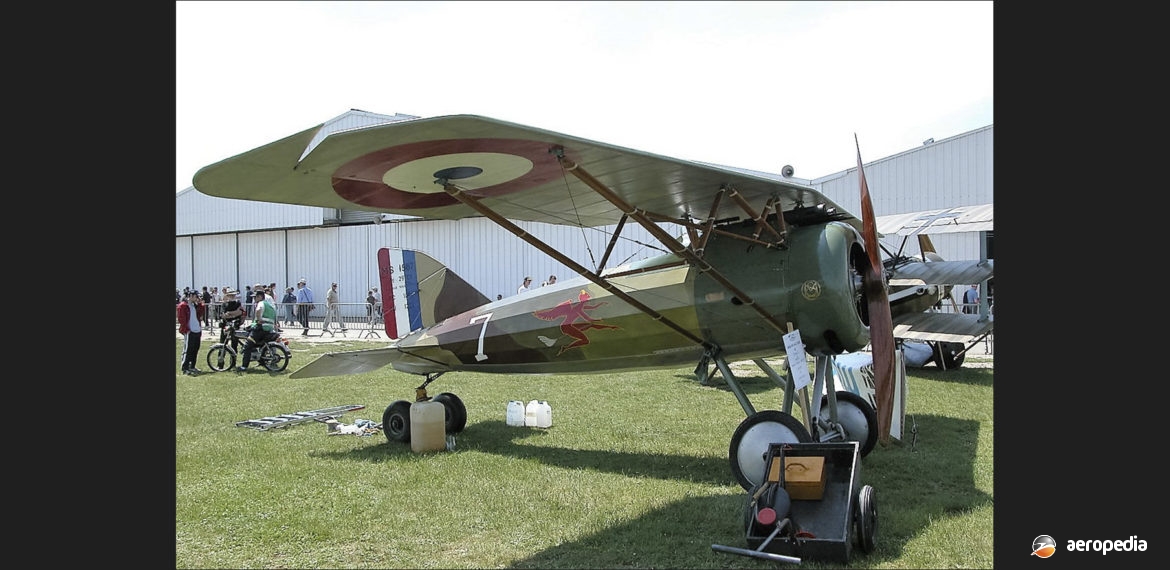Photograph:
Morane Saulnier AI on display at La Ferte Alaise in France (Author’s collection)
Country of origin:
France
Description:
Single-seat parasol wing fighter
Power Plant:
One 112 kw (150 hp) Gnome Monosoupape 9Nb nine-cylinder single-row rotary engine of 781.63 cub in weighing 137.4 kg (303 lb)
Specifications:
- Wingspan: 8.51 m (27 ft 10 in)
- Length: 5.65 m (18 ft 7 in)
- Height: 2.4 m (7 ft 8 in)
- Wing area: 13.39 m² (144.13 sq ft)
- Max speed at sea level: 221 km/h (137 mph)
- Max speed at 5,000 m (16,404 ft): 200 km/h (124 mph)
- Mas speed at 3,048 m (10,000 ft): 203 km/h (126 mph)
- Climb to 1,000 m (3,280 ft): 2 mins 20 secs
- Climb to 5,000 m (16,404 ft): 19 mins
- Climb to 3,048 m (10,000 ft): 8 mins 5 sec
- Service ceiling: 7,010 m (23,000 ft)
- Fuel capacity: 127 litres (28 Imp gals)
- Empty weight: 414 kg (913 lb)
- Loaded weight: 674 kg (1,486 lb)
Armament:
Two 7.7 mm (0.303 in) Vickers machine guns fixed on engine cowling and firing forward
History:
In 1917 Morane Saulnier designed two fighter aircraft using the fuselage that had been built for the Type AC and which had the Gnome Monosoupape rotary engine. The first was the Type AF, a biplane, and it was followed by the AI, which had a monoplane configuration. The Type AF was not built in numbers but the AI proved to be very successful.
The AI was constructed of metal, the rear fuselage being built from spruce. The AI fuselage was longer than the AF and the ventral fin was somewhat smaller. The tailplane was reduced in size and the elevator slightly increased in size. The wing was built in one piece and was of wooden construction with a slight sweepback. The wings had horn balanced ailerons and two struts on each side of the fuselage to brace the wings, these being supported by auxiliary struts at mid-span. The aircraft was of very sturdy design and the structure was carried over to further designs by the Company after World War I. The undercarriage was two lateral V-shaped steel tubes and one central V-shaped tube, there being a tailskid at the tail mounted on a tube which passed through the rudder.
The prototype flew at Villacoublay, France in early August 1917 and performance was good, but even better performance was achieved when the Chauviere propeller was replaced by a unit from Levasseur. Armament was either a single Vickers machine gun with 500-rounds, or two machine guns with 800-rounds, the twin-gun fighter having enlarged tail surfaces.
Aviation Militaire placed an order for between 1,100 and 1,300 Type AIs and they were given the designation MoS.C1, this being the single machine gun variant; and MoS.29 C1 for the two-gun variant. It is estimated that between 1,050 and 1,200 examples were completed. The type was used by French units over the Somme, being used for fighter patrols, bomber escort, and trench-strafing. Eventually the type was rapidly withdrawn from service, it being believed there were problems with the Gnome engines with a number of engine failures at high altitude. An American pilot, Temple N Joyce, flew an example and is reported to have performed 300 consecutive loops.
The type was later used in the trainer role in teaching student pilots aerial combat manoeuvring. A variety of engines was installed for this purpose. Examples were supplied to Belgium, Czechoslovakia, Japan, Poland and Switzerland. Fifty-one examples of the MoS.30 trainer variant were supplied to American training units at Issoudun in France.
In late 2014 The Vintage Aviator Limited in Wellington, New Zealand came to an agreement with a French company and obtained a Type AI for restoration and flight for its collection of airworthy World War I aircraft at Masterton.

